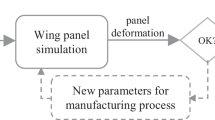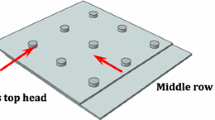Abstract
The fatigue property of riveted lap joint is greatly related to the riveting-induced residual stress, especially the stress distribution on the faying surface. However, an accurate study of the residual stress characteristics in the riveted sheet could be very difficult. In this paper, both numerical and experimental investigations were carried out on the stress/strain characteristics in riveted aircraft lap joints. A special specimen was designed for the test of strain variations on the faying surface of the sheet by microstrain gages. For the numerical simulation, the rivet squeezing process was analyzed using the explicit dynamic finite element (FE) method, whilst a general static FE analysis was employed for the elastic springback after the squeeze force was removed. A comparison of the strain variations between the experimental results and FE simulations shows a general good agreement, although there may be some difference for points measured near the hole surface. The FE analysis reveals that both compressive and tensile residual stresses could be introduced in the riveted sheet. Massive compressive residual stress can be created in the near-surface layer of the hole. However, the stress level is not always increased with increasing the squeeze force, and so is the improvement of fatigue life observed. Further study is still necessary to account for the fatigue life decreasing effect caused by a high squeeze force.
Similar content being viewed by others
References
A. Skorupa and M. Skorupa, Riveted Lap Joints in Aircraft Fuselage: Design, Analysis and Properties, Solid Mechanics and Its Applications, Springer Netherlands (2012).
C. Lei, Y. Bi, J. Li and Y. Ke, Experiment and numerical simulations of a slug rivet installation process based on different modeling methods, The International Journal of Advanced Manufacturing Technology, 97(1) (2018) 1481–1496.
C. D. Rans, R. C. Alderliesten and P. V. Straznicky, Assessing the effects of riveting induced residual stresses on fatigue crack behavior in lap joints by means of fractography, International Journal of Fatigue, 31(2) (2009) 300–308.
R. P. G. Muller, An Experimental and Analytical Investigation on the Fatigue Behavior of Fuselage Riveted Lap Joints: The Significance of the Rivet Squeeze Force, and a Comparison of 2024-t3 and Glare 3, Ph.D. Thesis (1995).
M. Skorupa, T. Machniewicz, A. Skorupa and A. Korbel, Fatigue life predictions for riveted lap joints, International Journal of Fatigue, 94 (2017) 41–57.
Y. Huang, H. Li, X. Yang, Z. D. Guan, Z. S. Li and Y. Sun, Improving the fatigue life of 2297-T87 Aluminum-Lithium alloy lugs by cold expansion, interference fitting, and their combination, Journal of Materials Processing Technology, 249 (2017) 67–77.
T. N. Chakherlou, M. Shakouri, A. B. Aghdam and A. Akbari, Effect of cold expansion on the fatigue life of al 2024-t3 in double shear lap joints: Experimental and numerical investigations, Materials & Design, 33 (2012) 185–196.
H. D. Gopalakrishna, H. N. Narasimha Murthy, M. Krishna, M. S. Vinod and A. V. Suresh, Cold expansion of holes and resulting fatigue life enhancement and residual stresses in al 2024 t3 alloy an experimental study, Engineering Failure Analysis, 17(2) (2010) 361–336.
H. Taghizadeh, T. N. Chakherlou and A. B. Aghdam, Prediction of fatigue life in cold expanded al-alloy 2024-t3 plates used in double shear lap joints, Journal of Mechanical Science and Technology, 27(5) (2013) 1415–1425.
P. F. P. De Matos, P. M. G. P. Moreira, P. P. Camanho and P. M. S. T. De Castro, Numerical simulation of cold working of rivet holes, Finite Elements in Analysis and Design, 41(9–10) (2005) 989–1007.
D. Backman and E. A. Patterson, A comparison of the effect of riveting and cold expansion on the strain distribution and fatigue performance of fiber metal laminates, Journal of Strain Analysis for Engineering Design, 49(3) (2014) 141–153.
T. N. Chakherlou, H. Taghizadeh and A. B. Aghdam, Experimental and numerical comparison of cold expansion and interference fit methods in improving fatigue life of holed plate in double shear lap joints, Aerospace Science and Technology, 29(1) (2013) 351–362.
Y. Li, An Analysis of Riveting Process by Theoretical Nonlinear Finite Element and Experimental Methods, Ph.D. Thesis (1998).
C. Rans, P. V. Straznicky and R. Alderliesten, Riveting process induced residual stresses around solid rivets in mechanical joints, Journal of Aircraft, 44(1) (2007) 323–329.
V. Blanchot and A. Daidie, Riveted assembly modelling: Study and numerical characterisation of a riveting process, Journal of Materials Processing Technology, 180(1–3) (2006) 201–209.
W. Wronicz, J. Kaniowski, B. Korzeniewski and E. Gadalinska, Experimental and numerical study of stress and strain field around the rivet, ICAF 2011 Structural Integrity: Influence of Efficiency and Green Imperatives, Montreal, Canada (2011) 277–288.
G. Li, G. Shi and N. C. Bellinger, Studies of residual stress in single-row countersunk riveted lap joints, Journal of Aircraft, 43(3) (2006) 592–599.
G. Li, G. Shi and N. C. Bellinger, Study of the residual strain in lap joints, Journal of Aircraft, 43(4) (2006) 1145–1151.
A. Skorupa, M. Skorupa, T. Machniewicz and A. Korbel, Fatigue crack location and fatigue life for riveted lap joints in aircraft fuselage, International Journal of Fatigue, 58 (2014) 209–217.
C. Zeng, W. H. Liao and W. Tian, Influence of initial fit tolerance and squeeze force on the residual stress in a riveted lap joint, The International Journal of Advanced Manufacturing Technology, 81(9–12) (2015) 1643–1656.
C. Zeng, W. Tian and W. H. Liao, Improved model concerning driven rivet head dimensions based on material flow characteristics, Journal of Aircraft, 53(4) (2016) 1179–1184.
S. H. Cheraghi, Effect of variations in the riveting process on the quality of riveted joints, International Journal of Advanced Manufacturing Technology, 39(11–12) (2008) 1144–1155.
J. J. M. deRijck, J. J. Homan, J. Schijve and R. Benedictus, The driven rivet head dimensions as an indication of the fatigue performance of aircraft lap joints, International Journal of Fatigue, 29(12) (2007) 2208–2218.
Z. P. Chang, Z. Q. Wang, B. B. Wang, Y. G. Kang and Q. Luo, Riveting force computation model based on formed head inhomogeneous deformation, Acta Aeronautica et Astronautica Sinica, 37(7) (2016) 2312–2320.
L. Wang, W. Tian, L. Zhang and C. Zeng, Prediction model of riveting force based on simulation analysis, Aeronautical Manufacturing Technology (22) (2017) 56–60.
M. Skorupa, A. Skorupa, T. Machniewicz and A. Korbel, Effect of production variables on the fatigue behavior of riveted lap joints, International Journal of Fatigue, 32(7) (2010) 996–1003.
X. Z. Hao, M. Wang and W. L. Chen, Experimental research of best interference fit level on automatic drilling and riveting, Aeronautical Manufacturing Technology (12) (2012) 77–79.
Z. Q. Cao and Q. L. Zhang, Fatigue Enhancing Theory of Interference Fit and Its Application in Aircraft Structures, National Defense Industry Press, Beijing, China (2006).
Acknowledgments
This work was partially supported by the National Natural Science Foundation of China (Grant No. 51575273) and the Specific Funds for Integrated Military-Civilian Development from Guizhou Institute of Technology (Grant No. KJZX17-011) and Natural Science Foundation of Guizhou Province (Grant No. 20161065).
Author information
Authors and Affiliations
Corresponding author
Additional information
Recommended by Associate Editor Zhuhua Tan
Chao Zeng is an Associate Professor of the School of Aerospace Engineering, Guizhou Institute of Technology, Guiyang, China. He received his Ph.D. in aerospace manufacturing engineering from Nanjing University of Aeronautics and Astronautics. His research interests include aircraft assembly, strength evaluation, and fatigue.
Rights and permissions
About this article
Cite this article
Zeng, C., Tian, W., Liu, X.Y. et al. Experimental and numerical studies of stress/strain characteristics in riveted aircraft lap joints. J Mech Sci Technol 33, 3245–3255 (2019). https://doi.org/10.1007/s12206-019-0620-7
Received:
Revised:
Accepted:
Published:
Issue Date:
DOI: https://doi.org/10.1007/s12206-019-0620-7




